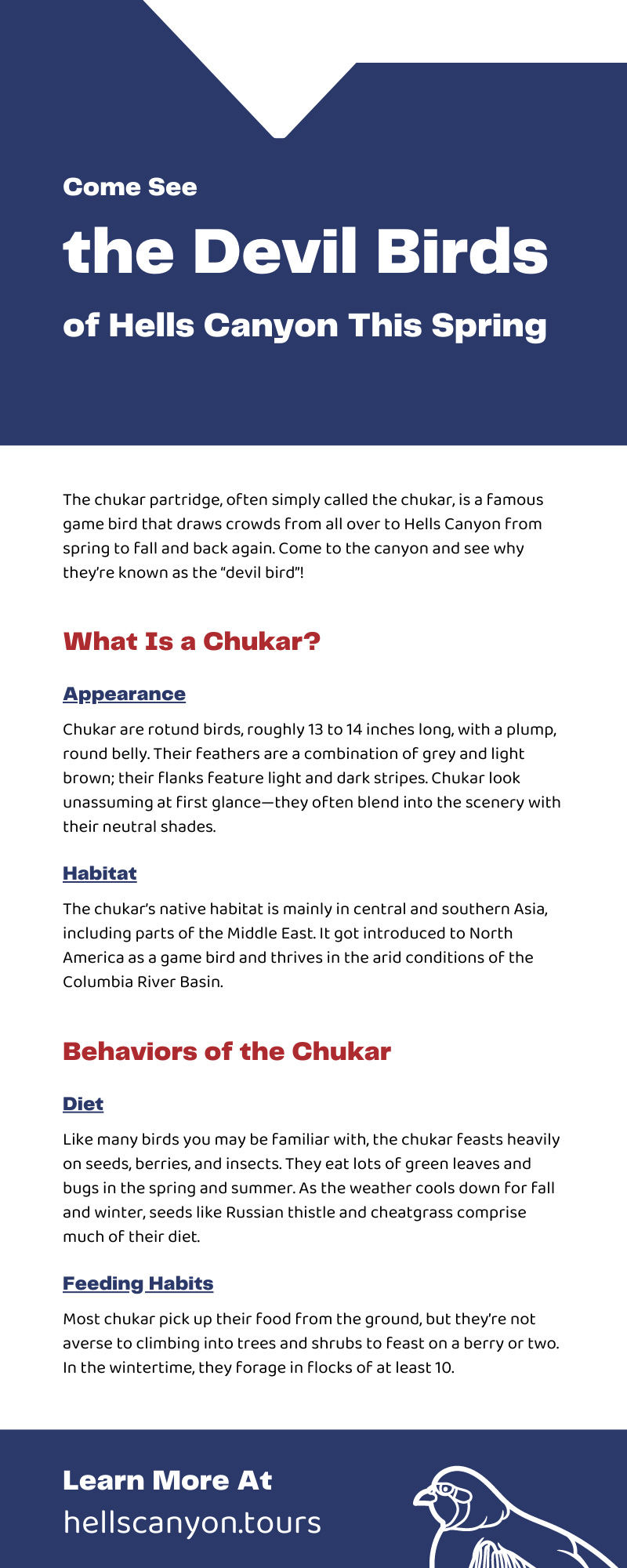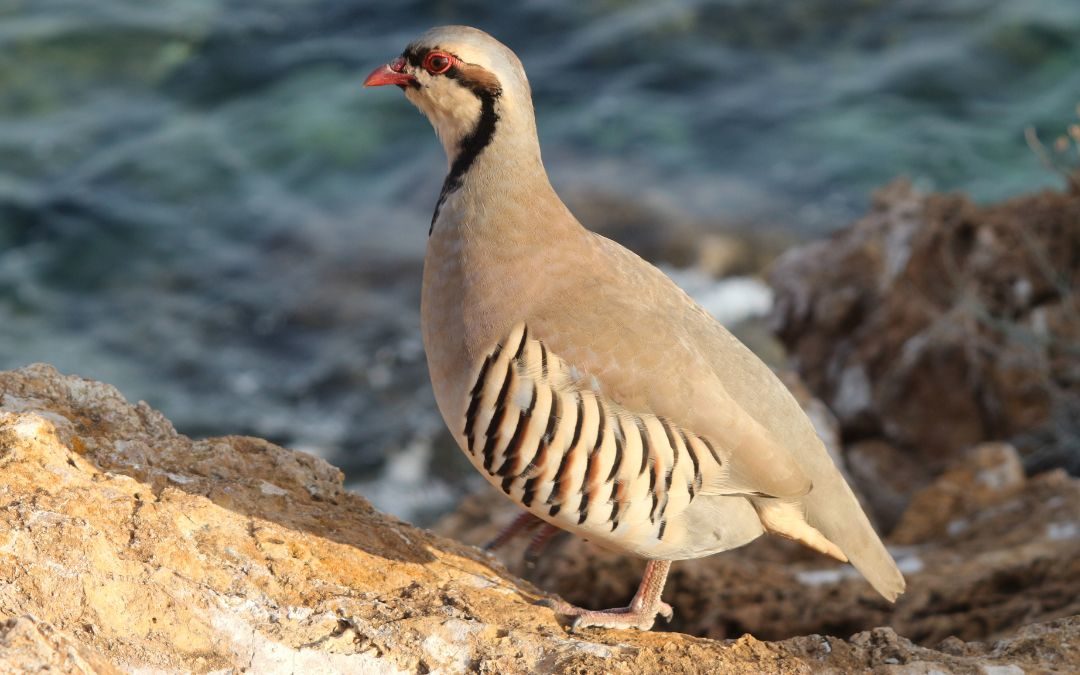When you arrive in Hells Canyon, many outdoor activities await you. From hiking to fishing to jet boat tours, the canyon has it all! Use your trip as an opportunity to commune with the natural world, including all the wild animals that call Hells Canyon their home. One such animal is the chukar, read on to learn more about these birds!
The chukar partridge, often simply called the chukar, is a famous game bird that draws crowds from all over to Hells Canyon from spring to fall and back again. Come to the canyon and see why they’re known as the “devil bird”!
What Is a Chukar?
If you’ve never seen a chukar before, get ready to see them in droves in the spring!
Appearance
Chukar are rotund birds, roughly 13 to 14 inches long, with a plump, round belly. Their feathers are a combination of grey and light brown; their flanks feature light and dark stripes. Chukar look unassuming at first glance—they often blend into the scenery with their neutral shades.
Look for the chukar’s stark white face, framed by a band of black feathers called a gorget. Their bill is an unmistakable shade of bright red.
Habitat
The chukar’s native habitat is mainly in central and southern Asia, including parts of the Middle East. It got introduced to North America as a game bird and thrives in the arid conditions of the Columbia River Basin.
The best chukar hunting on this continent is in Idaho and Oregon, especially the Hells Canyon area. Many adventure companies in the area, including River Adventures, offer exciting “cast and blast” trips in the fall that allow you to fish the Snake River and hunt for chukar!
Call
The chukar get their name from the sound they make: a raspy call that sounds like “chuk-chuk-chuka”! Territorial males most commonly make this cackling sound.
Behaviors of the Chukar
To find and hunt chukar, you’ve got to have a feel for their lifestyle. When and where can you find these “devil birds”? What is the day-to-day schedule of the chukar?
Diet
Like many birds you may be familiar with, the chukar feasts heavily on seeds, berries, and insects. They eat lots of green leaves and bugs in the spring and summer. As the weather cools down for fall and winter, seeds like Russian thistle and cheatgrass comprise much of their diet.
Many of the chukar’s food sources come from plants introduced from Eurasia, just like they were.
Feeding Habits
Most chukar pick up their food from the ground, but they’re not averse to climbing into trees and shrubs to feast on a berry or two. In the wintertime, they forage in flocks of at least 10.
Bathing
Chukar take dust baths just about every day! They create depressions in the ground and flail about, scratching and covering themselves in the dust to keep their feathers clean.
Courting and Nesting
To court a prospective mate, male chukar circle around the female with their head tilted. Both birds put on mock feeding displays, and the male may feed the female seeds, berries, or insects.
Then the female chukar creates a nest on the ground out of twigs and grasses, often hidden under a shrub, a bush, or an overhanging rock.
Laying Eggs
The breeding season for chukar is between April and July. The female chukar lays between eight and 14 eggs, though some will lay more than 20. The eggs are a pale yellow-beige, spotted with warm shades of reddish brown. The incubation period is usually between 22 and 24 days.
For the most part, the female does the work of incubating those eggs. However, some may lay two separate clutches, so the male can incubate one while the female takes care of the other.
Chukar Chicks
Young chukar are relatively independent, leaving the nest shortly after they hatch. Their mother does more of the feeding than their father, but chicks can find their own food within a few short days.
Chicks often learn to fly within 10 days of hatching, reaching their full size within two months.
How To Spot a Chukar
The best time to see chukar in Hells Canyon is springtime, but you can see them all year round! Between March and May, you’ll hear the males’ distinctive calls from nearly every rocky cliff and outcropping!
Keep your eyes peeled and your ears open. Despite how bold chukar look in pictures, with their distinctive and contrasting markings, they tend to blend in with rocky, uneven backgrounds. Bring a pair of binoculars along, and follow the noise when you hear their distinctive cackling call.
Another great place to spot chukar is near water sources like the Snake River. While chukar fare well in rocky conditions with limited water, they’ve still got to take a sip every so often! Watch your step and mind the amount of noise you make as you search near the water for chukar hydrating themselves.
Tips for Hunting Chukar
River Adventures is famous for the best Hells Canyon jet boat tours around, and our tour guides also offer insider tips for hunting and fishing in the area.
While you can spot chukar all throughout the year, hunting seasons occur between fall and the end of January each year, so plan your trip accordingly. When you visit Hells Canyon, ask us how the chukar are doing!
Here are a few essential tips to get you started:
Look For Water
While chukar also love to spend time on cliffs and rocky outcroppings, they need a water source nearby. Stay close to water sources like ponds, streams, or the Snake River itself.
Travel Light
Chukar are the “devil birds” of Hells Canyon because they push even the most dedicated hunters to their limits! Be prepared to cover lots of ground on a wild chase. Streamline your clothing and equipment for the day to avoid getting tired and bogged down.
Find Their Coveys
When you happen upon a covey (small flock) of chukar, mark it in your GPS and note the conditions under which you found it. Chukar like to use the same spots for their nests year after year. When you find one of their home bases, chances are you can return to it on future trips for all-but-guaranteed game to hunt!
Don’t Get Discouraged
Experienced hunters like to say, “The first time you hunt chukar is for fun. Every time after that is for revenge.”
Chukar hunting is a serious workout. You’ll cover lots of rocky terrain as you pursue them, and you may end your day without successfully shooting anything. It’s all part of the sport; chukar hunting is not for the easily disappointed or the faint of heart.
If you find limited success on your chukar hunting trip, don’t give up—try again another day with the knowledge you’ve gained! The sport is in the chase.
When you visit Hells Canyon, come see the devil birds and learn how they got their nickname. Chukar populations are athletic, elusive, and easy to identify: three characteristics that make it an ideal game bird for spotting and sport hunting!


Recent Comments